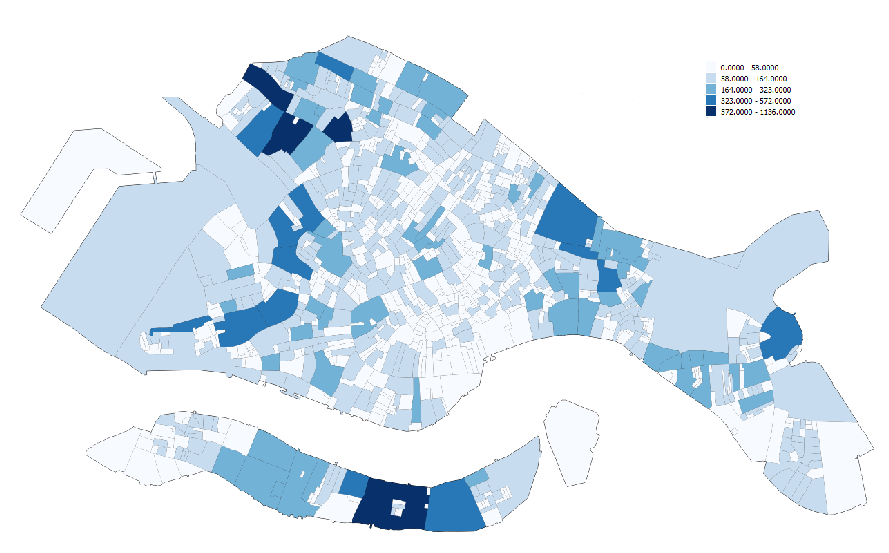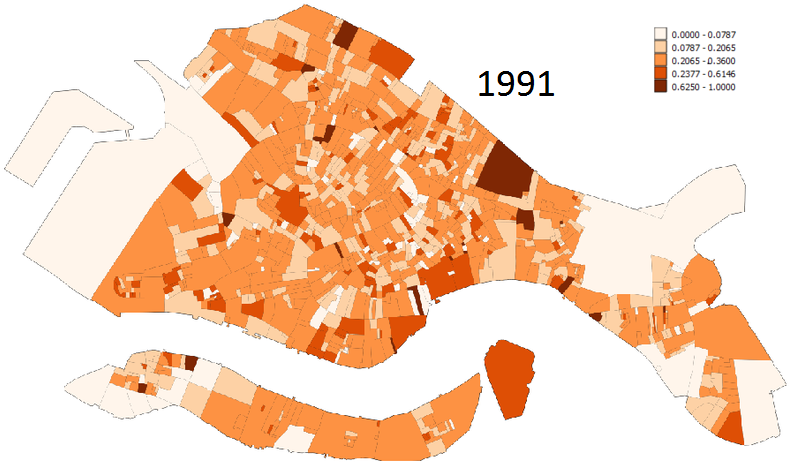Census 1991: Difference between revisions
Algorowara (talk | contribs) No edit summary |
Algorowara (talk | contribs) |
||
| Line 30: | Line 30: | ||
While the population of Venice is sparse, it has a surprisingly high proportion of elderly citizens, with the elderly population of many census tracts - even in the center of the city - exceeding 20%. In fact, the proportion of elderly persons in the population is more evenly distributed than the actual population, indicating that the management of care of the elderly is an issue which is relevant to all of Venice, not just certain localities. | While the population of Venice is sparse, it has a surprisingly high proportion of elderly citizens, with the elderly population of many census tracts - even in the center of the city - exceeding 20%. In fact, the proportion of elderly persons in the population is more evenly distributed than the actual population, indicating that the management of care of the elderly is an issue which is relevant to all of Venice, not just certain localities. | ||
Once again, northern [[Cannaregio]] pops up as an area of significance. While in terms of population alone, it is remarkable but not astounding, it is a large area with an incredible density of senior citizens - in fact, they make up the majority of inhabitiants in that area. This seems to support the theory mentioned above that the [http://www.ulss12.ve.it/sediOspedaliere.aspx?idP=4 Ospedale] is a significant draw for locals, as the disproportionately large population of elderly Venetians is the demographic group most in need of nearby health services. | Once again, northern [[Cannaregio]] pops up as an area of significance. While in terms of population alone, it is remarkable but not astounding, it is a large area with an incredible density of senior citizens - in fact, they make up the majority of inhabitiants in that area. This seems to support the theory mentioned above that the [http://www.ulss12.ve.it/sediOspedaliere.aspx?idP=4 Ospedale] is a significant draw for locals, as the disproportionately large population of elderly Venetians is the demographic group most in need of nearby health services. | ||
Revision as of 15:41, 13 November 2013
This images are graphical representations of the population density of the city of Venice in the year 1991, broken down by census tract, as carried out by the ISTAT, or Istituto nazionale di statistica (in English: Italian National Institute of Statistics).
Census by Tract
The census is broken down into over one thousand subdivisions, each of which is a distinct geographical area below. Statistics are kept with the census tract at the smallest unit of measure, and as a result, the graphics below show these discrete chunks, coloring each one according to the appropriate statistical range.
Population
The key here indicates the number of persons living in the given census tract. It is not scaled by area.
Working Population
The key here indicates the number of persons working in the given census tract. It is not scaled by area.
Elderly Population
The key here indicates the proportion of persons living in the given census tract who are elderly (65+ years).
Characteristics of the 1991 Census
The 1991 Census reveals an aging population which has spread mostly to the outskirts of the city, leaving the center to storefronts and tourists. While a more detailed analysis goes beyond the scope of the census and enters the realm of sociological research, it is not inappropriate to say that the maps of the city suggest a departure - particularly of the young - from a city overwhelmed by tourism.
Population
Unsurprisingly, the center of Venice - particularly near the Piazza San Marco, a popular tourist destination which is very vulnerable to floods - is sparsely populated, having been taken up by commercial locations of varying sorts. Of note is an area of moderate population density in northern Cannaregio, which may be attractive due to its proximity to the Ospedale SS. Giovanni e Paolo, a large hospital. Additionally, the spatious northwestern corner of Venice is well-populated, possibly because it is out of the way of many typical tourist attractions.
Elderly Population
While the population of Venice is sparse, it has a surprisingly high proportion of elderly citizens, with the elderly population of many census tracts - even in the center of the city - exceeding 20%. In fact, the proportion of elderly persons in the population is more evenly distributed than the actual population, indicating that the management of care of the elderly is an issue which is relevant to all of Venice, not just certain localities.
Once again, northern Cannaregio pops up as an area of significance. While in terms of population alone, it is remarkable but not astounding, it is a large area with an incredible density of senior citizens - in fact, they make up the majority of inhabitiants in that area. This seems to support the theory mentioned above that the Ospedale is a significant draw for locals, as the disproportionately large population of elderly Venetians is the demographic group most in need of nearby health services.

